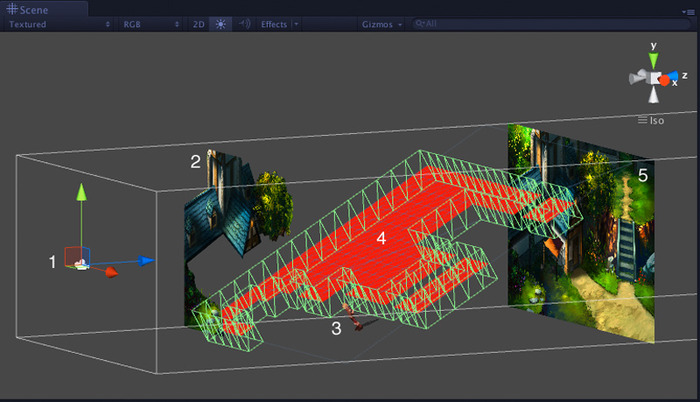Archive for
Hi everyone!
We’re a bit overdue since a lot’s been going on, but we’ve been working hard to get things ready to share with you. To start, I wanted to let Kalen and Aakaash share some insights into our progress on art and sound.
Art
Over the last few weeks, we’ve been honing in on the new look for our in-game environments. To start, I created some rough exploration sketches:

From there, I created a line art of the in-game art style. At this stage, we started looking into how we can add depth and perspective into the game, while adhering to the grid that will be required for player movement and tactical gameplay.

Since we’ll need to create lots of environments, I created a modular texture set to help speed things along:

From there, I used the textures to fill in our line sample, and we moved on to exploring color and rendering style:

After a few iterations, here’s a sample of the final in-game environmental art style we arrived at:

Here’s another version, with the movement grid shown:

– Kalen
Sound
I’m excited to say that now that John and I have finished hashing out the general soundtrack details, composition for Liege has begun in earnest. As mentioned in the earlier sound update, one thing I’m really looking to do with the soundtrack is to use motifs to represent certain characters or emotions. I’ll be bringing these motifs back several times in the various tracks of the score and developing them as the plot itself develops. My goal is not only to add a sense of cohesiveness and continuity to the OST, but also to evoke familiar emotions and themes when a previously introduced motif is used again.
Today, I’d like to share with you Seren’s Theme, a duet for violin and piano:
The melody you hear in the piece, introduced by the piano and then repeated on the violin, will serve as the motif associated with Seren. This track will likely not be used as is in game, which is why it may sound a bit disconnected at present; instead, I’ll be working the melody into several different pieces to score scenes that center around Seren. For example, in the piece featured in the earlier sound update, “A Quiet Farewell,” you’ll recognize variations of these melodies.
Many of the games I’ve worked on in the past have been less story-based and thus have required less thematic soundtracks; ambient environmental tracks, rather than more involved melodic pieces, were the norm. In this sense, Liege presents both an opportunity and a challenge. Because the soundtrack calls for strong melodies, composition begins at the piano rather than at the computer. Motifs and melodies have to be memorable enough that the player will recognize it when it reoccurs in a different form later in the game, yet they have to remain flexible enough that I’ll be able to work them into several tracks of varying moods. The process of composing forLiege is certainly quite different than what I’m used to, but if all goes well, it’ll pay off in the completed product.
– Aakaash
Development
As mentioned in previous posts, I’ve been working on implementing our framework and workflow in our new engine (Unity). For those interested on the technical side of things, I wanted to share a bit about what’s going on behind the scenes.
Going into our Unity port, I had a few key requirements apart from simply porting over existing functionality:
- Layered 2D environments with 3D character models
- In-game skeletal animation (for smoother animation and effects like slo-mo)
- Real-time, dynamic shadows
- Efficient workflow that leverages Unity’s WYSIWYG editing features
- Acceptable performance with the above on our weaker hardware targets (mobile)
Below, you can see how our scene is composed in our editor with the above features in place:

Going from left to right, we have:
1. A system of cameras that controls the order in which the scene is drawn
2. Parts of the scene that are normally drawn over characters (i.e. trees)
3. 3D characters casting real-time shadows, rotated to align with our view (note the model is a placeholder)
4. Collision bounds, which are automatically generated from a 2D tile map
5. Parts of the scene that are normally drawn behind characters (i.e. the ground)
Here’s the game running in our editor (with an older iteration of Kalen’s art):

As you can see, our content aligns precisely to form the composite image that’s seen in-game. This is very different from how 2D is normally handled, but it opens up lots of interesting graphical possibilities.
As this update hopefully shows, things are taking some time as we try things and iterate, but the updates will be more regular as we get further along. Thanks as always for your support!



